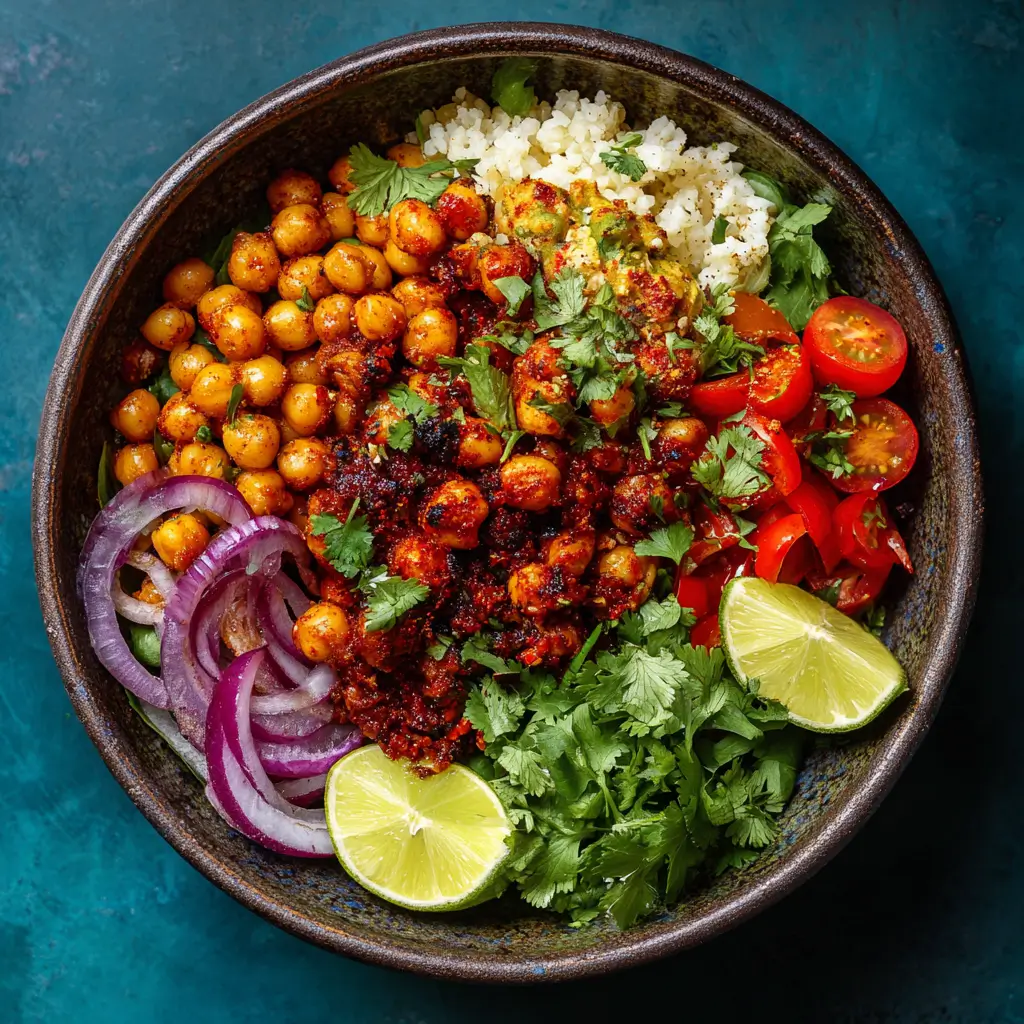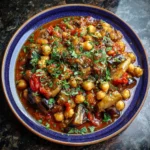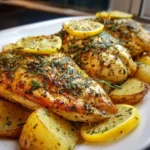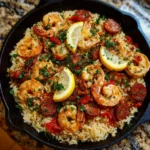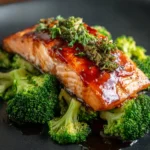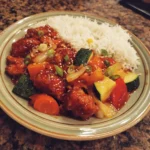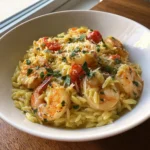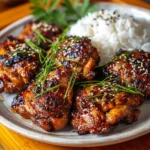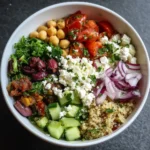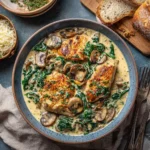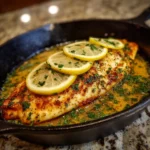Spicy Harissa Chickpea Bowls: A Flavor-Packed, Nutrient-Rich Meal for Every Palate
If you’re searching for a vibrant, satisfying, and health-conscious meal that bursts with bold flavors and Middle Eastern-inspired flair, look no further than Spicy Harissa Chickpea Bowls. These hearty bowls combine protein-rich chickpeas with fiery harissa paste, aromatic spices, fresh vegetables, and wholesome grains to create a dish that’s as nutritious as it is delicious. Whether you’re vegan, vegetarian, or simply trying to incorporate more plant-based meals into your diet, this recipe offers a balanced, energizing option that’s easy to customize and perfect for weeknight dinners, meal prep, or even weekend entertaining.
The History of Harissa and Its Culinary Evolution
Harissa, the North African chili paste that forms the soul of this dish, originates from Tunisia and has since spread across the Maghreb region, including Algeria, Libya, and Morocco. Traditionally made from roasted red peppers, dried chilies (such as Baklouti or serrano), garlic, olive oil, and warm spices like cumin and coriander, harissa serves as both a condiment and a cooking base in many regional dishes. The word “harissa” comes from the Arabic verb “harasa,” meaning “to pound” or “to crush,” reflecting the traditional method of grinding ingredients using a mortar and pestle.
Over centuries, harissa became a staple in North African kitchens and was later embraced by global cuisines thanks to migration and cultural exchange. In recent years, its popularity has surged in Western culinary scenes due to its complex heat, smoky depth, and versatility. When paired with legumes like chickpeas—longtime dietary staples across the Mediterranean and Middle East—it creates a fusion of flavor and nutrition that resonates with modern food lovers seeking bold tastes and plant-powered meals.
Ingredients Breakdown: Building Layers of Flavor and Nutrition
The magic of Spicy Harissa Chickpea Bowls lies not only in their fiery kick but also in the thoughtful layering of ingredients that contribute to taste, texture, color, and nutritional balance. Each component plays a vital role:
- Chickpeas: Also known as garbanzo beans, these legumes are rich in plant-based protein, fiber, iron, and folate. They provide a meaty texture and soak up the spicy harissa marinade beautifully.
- Harissa Paste: This is the star ingredient. Available in tubes, jars, or homemade versions, harissa brings heat, smokiness, and complexity. Choose mild, medium, or hot based on your spice tolerance.
- Olive Oil: Used to coat the chickpeas before roasting, extra virgin olive oil adds richness, helps crisp the exterior, and carries fat-soluble nutrients.
- Garlic & Spices: Minced garlic, ground cumin, smoked paprika, and a pinch of cinnamon deepen the savory profile and complement the heat of the harissa.
- Quinoa or Brown Rice: As a base grain, quinoa offers complete protein and a light, fluffy texture. Brown rice provides chewiness and sustained energy from complex carbohydrates.
- Roasted Vegetables: Common additions include bell peppers, zucchini, red onion, and cherry tomatoes, which add sweetness, color, and antioxidants.
- Fresh Toppings: Chopped cucumber, parsley, mint, red onion, and lemon zest bring brightness and contrast to the spiciness.
- Tahini Sauce: A creamy blend of tahini, lemon juice, garlic, water, and salt drizzled over the top enhances richness and cools the palate.
- Lemon Juice: Essential for acidity, balancing the heat and enhancing all other flavors.
- Salt & Pepper: For seasoning and bringing everything together.
Optional extras can include crumbled feta cheese (for non-vegan versions), olives, pickled red onions, avocado slices, or a fried or poached egg for added protein and luxury.
Step-by-Step Recipe: Crafting Your Perfect Bowl
Follow this detailed guide to assemble restaurant-quality Spicy Harissa Chickpea Bowls at home. With proper timing and organization, you’ll have a stunning, flavorful meal ready in under an hour.
Prep Time: 15 minutes | Cook Time: 35–40 minutes | Total Time: ~55 minutes | Servings: 4
Ingredients
- 2 cans (15 oz each) chickpeas, drained, rinsed, and patted dry
- 3 tablespoons harissa paste (adjust to taste)
- 2 tablespoons extra virgin olive oil
- 3 cloves garlic, minced
- 1 teaspoon ground cumin
- 1 teaspoon smoked paprika
- ½ teaspoon ground cinnamon (optional, for warmth)
- Salt and freshly ground black pepper, to taste
- 1 cup uncooked quinoa (or 3 cups cooked brown rice)
- 2 cups water or vegetable broth (for cooking quinoa)
- 1 red bell pepper, sliced
- 1 yellow bell pepper, sliced
- 1 small zucchini, halved and sliced
- 1 red onion, cut into wedges
- 1 cup cherry tomatoes, halved
- 1 English cucumber, diced
- ¼ cup chopped fresh parsley
- ¼ cup chopped fresh mint
- 1 lemon, juiced and zested
- ½ cup tahini
- 2–3 tablespoons lemon juice (for tahini sauce)
- 1 clove garlic, minced (for tahini sauce)
- 3–5 tablespoons water (for thinning tahini sauce)
- Optional toppings: crumbled feta, avocado, pickled onions, olives, toasted pine nuts or almonds
Directions
- Cook the Grain Base: Rinse the quinoa thoroughly under cold water. In a medium saucepan, combine quinoa and water or vegetable broth. Bring to a boil, then reduce heat to low, cover, and simmer for 15 minutes or until liquid is absorbed and quinoa is fluffy. Remove from heat, fluff with a fork, and let stand covered for 5 minutes. Alternatively, prepare brown rice according to package instructions.
- Prepare the Harissa Chickpeas: Preheat oven to 400°F (200°C). On a large baking sheet, toss the dried chickpeas with olive oil, harissa paste, minced garlic, cumin, smoked paprika, cinnamon (if using), salt, and pepper. Spread evenly in a single layer to ensure crispiness. Roast for 25–30 minutes, flipping halfway through, until golden and slightly crispy. Remove and let cool slightly.
- Roast the Vegetables: While the chickpeas roast, place bell peppers, zucchini, red onion, and cherry tomatoes on another baking sheet. Drizzle with 1 tablespoon olive oil, season with salt and pepper, and toss to coat. Roast for 20–25 minutes, stirring once, until tender and caramelized at the edges.
- Make the Tahini Sauce: In a small bowl, whisk together tahini, lemon juice, minced garlic, and a pinch of salt. Gradually add water, one tablespoon at a time, until the sauce reaches a smooth, pourable consistency. Taste and adjust seasoning—add more lemon for tang or salt for balance.
- Assemble the Bowls: Divide the cooked quinoa or brown rice among four serving bowls. Top with roasted harissa chickpeas, roasted vegetables, fresh cucumber, cherry tomatoes, herbs (parsley and mint), and any optional toppings. Drizzle generously with tahini sauce and finish with a squeeze of fresh lemon juice and a sprinkle of lemon zest.
- Serve Immediately: Enjoy while warm for the best flavor and texture contrast between the crispy chickpeas, soft grains, and fresh toppings.
Tips for Success
- Dry the Chickpeas Well: Patting them dry before roasting removes excess moisture, which is key to achieving crispy, crunchy chickpeas instead of soggy ones.
- Adjust Harissa Heat: Start with 1–2 tablespoons if you’re sensitive to spice. You can always serve extra harissa on the side for those who want more fire.
- Use Homemade Harissa (Optional): For deeper flavor, make your own harissa paste using rehydrated dried chilies, garlic, olive oil, and spices. It keeps well in the fridge for weeks.
- Meal Prep Friendly: Roast chickpeas and vegetables, cook quinoa, and prepare tahini sauce up to 4 days ahead. Store components separately in airtight containers and assemble bowls fresh when ready to eat.
- Add Acid at the End: A final splash of lemon juice just before serving brightens the entire dish and cuts through the richness.
- Boost Protein: Add grilled tofu, tempeh, falafel, or a poached egg to transform the bowl into a high-protein powerhouse.
- Toast the Grains (Optional): Lightly toast quinoa in a dry pan before cooking to enhance nuttiness and depth.
Variations and Customizations
One of the greatest strengths of Spicy Harissa Chickpea Bowls is their adaptability. Here are creative ways to switch things up:
- Grain Alternatives: Swap quinoa for farro, bulgur, freekeh, couscous, or cauliflower rice for lower-carb options.
- Different Legumes: Try white beans, lentils, or black beans instead of chickpeas for variety.
- Vegetable Swaps: Use sweet potatoes, eggplant, broccoli, or carrots as roasted elements. Massaged kale or shredded cabbage work well raw.
- Sauce Variations: Replace tahini sauce with yogurt-dill sauce (dairy or plant-based), cilantro-lime crema, or harissa aioli.
- Mediterranean Twist: Add kalamata olives, sun-dried tomatoes, artichoke hearts, and feta for a Greek-inspired version.
- North African Fusion: Include preserved lemons, dates, apricots, and toasted almonds for a Moroccan tagine-style bowl.
- Spice Infusions: Add a pinch of cayenne, berbere, or ras el hanout to the chickpea mixture for extra warmth.
- Raw & Crunchy Version: Skip roasting and use raw spiced chickpeas (marinated and chilled) with shredded carrots, radishes, and cabbage for a deconstructed salad bowl.
Health Considerations and Nutritional Value
Spicy Harissa Chickpea Bowls are not only delicious but also packed with health-promoting nutrients. Here’s a breakdown of what makes this dish a smart choice:
- High in Fiber: Chickpeas and whole grains support digestive health, promote satiety, and help regulate blood sugar levels.
- Plant-Based Protein: With approximately 15–20 grams of protein per serving (depending on additions), this bowl supports muscle maintenance and repair without relying on animal products.
- Heart-Healthy Fats: Olive oil and tahini provide monounsaturated fats, which are beneficial for cardiovascular health and inflammation reduction.
- Rich in Antioxidants: Colorful vegetables and spices like turmeric (if added), cumin, and paprika contain compounds that combat oxidative stress.
- Low Glycemic Index: The combination of fiber, protein, and healthy fats ensures slow energy release, making this meal ideal for sustained focus and appetite control.
- Gluten-Free Option: Naturally gluten-free when using certified grains, making it suitable for those with celiac disease or gluten sensitivity.
- Vegan & Dairy-Free: Easily adaptable to plant-based diets—just skip feta or use a vegan alternative.
- Anti-Inflammatory Properties: Ingredients like garlic, olive oil, lemon, and spices contribute to reducing chronic inflammation.
Nutritional Estimate (per serving, without optional toppings):
- Calories: ~480
- Protein: 16g
- Fat: 22g (mostly unsaturated)
- Carbohydrates: 58g
- Fiber: 13g
- Sugar: 8g (natural from vegetables)
- Sodium: Varies (reduce by using low-sodium canned chickpeas and limiting added salt)
Note: Values may vary based on specific brands and ingredient proportions.
FAQ (Frequently Asked Questions)
Can I use dried chickpeas instead of canned?
Yes! Soak 1 cup dried chickpeas overnight, then boil until tender (about 1–1.5 hours). Drain and pat dry before using. This method yields creamier, more flavorful chickpeas but requires advance planning.
Is harissa very spicy?
It depends on the brand and type. Some harissa pastes are mildly smoky, while others are intensely hot. Start with less and adjust to your preference. You can also mix harissa with olive oil or yogurt to mellow the heat.
How long do leftovers last?
Stored in airtight containers in the refrigerator, components will keep for 4–5 days. Reheat chickpeas and grains gently in a skillet or microwave. Add fresh toppings and sauce just before serving.
Can I freeze this dish?
While the roasted chickpeas and grains can be frozen for up to 3 months, thawed textures may soften. Best to freeze components separately and refresh with fresh veggies and sauce upon reheating.
What can I substitute for tahini?
Try almond butter, cashew butter, or sunflower seed butter for a similar creamy texture. Note that flavor will differ slightly.
Are these bowls kid-friendly?
For milder palates, reduce or omit harissa, increase sweet roasted vegetables, and serve with a simple lemon-tahini sauce. Let kids customize their own bowls for fun and engagement.
Can I make this oil-free?
Yes! Roast chickpeas and vegetables using a splash of vegetable broth or aquafaba (chickpea brine) instead of oil. Use water-thinned tahini sauce without added oil.
Summary
Spicy Harissa Chickpea Bowls are a celebration of bold flavors, vibrant colors, and nourishing ingredients that come together in a harmonious, customizable meal. Packed with plant-based protein, fiber, and heart-healthy fats, they’re as good for your body as they are for your taste buds.
